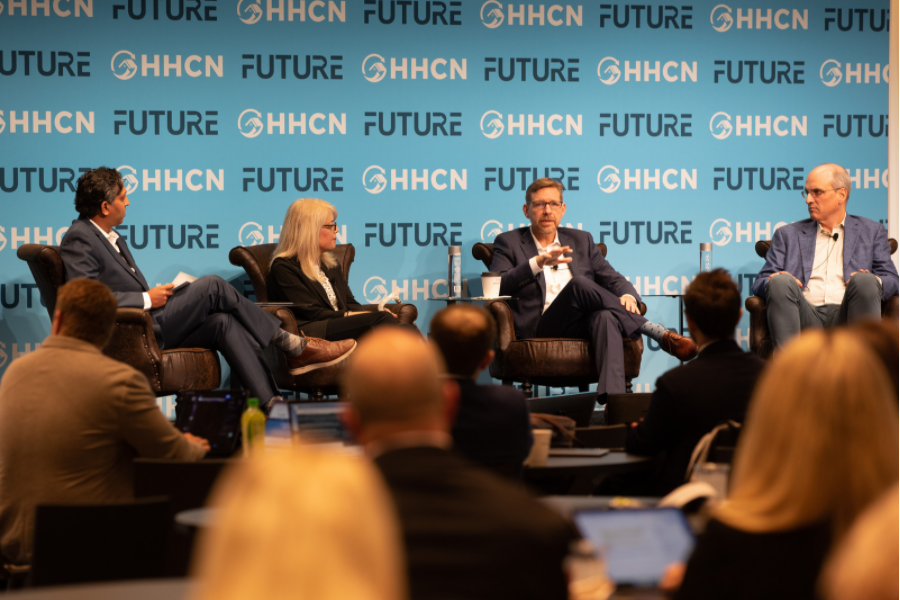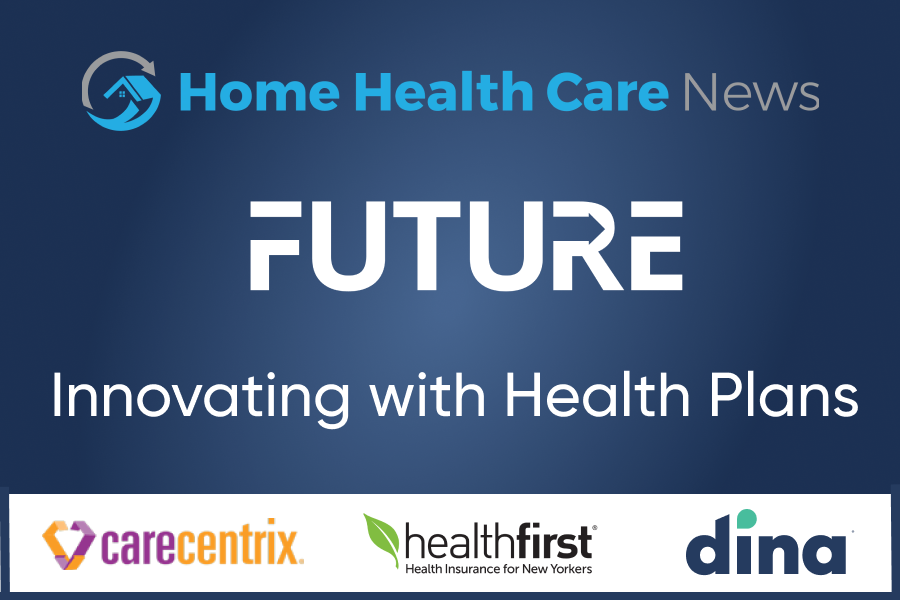
As care-at-home continues to accelerate, health plans play an important role in making home-based care more accessible and available to their members.
Dina CEO Ashish V. Shah (far left) led the recent “Innovating With Health Plans” panel at the Home Health Care News FUTURE conference, where he and health plan leaders talked about why they value “boots on the ground,” and how care providers can work with plans to drive outcomes.
Shah was joined by (from left to right) Sheryl Markowitz, senior vice president of clinical operations at Healthfirst; Steve Wogen, chief growth officer at CareCentrix; and G.T. Sweeney, chief information officer at Healthfirst. Following is an edited version of the discussion.
Focus on Data, Outcomes

Wogen: Most organizations are trying to work with multiple health plans, and every health plan has a different perception of what value-based looks like. We’re trying to bring some standards to how a health plan may think about that, and then work with providers in a very different way to connect them to health plans with one unified model.
And if we can do that successfully, it streamlines the work for everybody involved, it drives more value to the system, and it helps us accelerate the push towards value-based care. But it’s going to be a journey and part of making it real is technology. It is the enabler to make it work.
Shah: The unique opportunity we have right now is the shift into the home, and technology really makes that possible. G.T., can you share your perspective on the role technology plays in all of this?
Sweeney: It’s a big challenge and it’s a big opportunity, but the time is now to use technology to drive collaboration. I think the next five years are going to be characterized by a digital disruption that changes the way everybody participates in the healthcare ecosystem and makes it easier for consumers to access care.
But if we’re going to make it easier for consumers, we’ve got to make it easier for those who deliver care as well. I’m talking about home
healthcare workers, home healthcare specialists, and unpaid caregivers. Now is the time to embrace technology to make it easier for everyone who participates in the delivery of care.
Shah: When we think about home-based providers, there’s a plethora of solutions, and then there are some folks who haven’t yet started that technology adoption. How do organizations partner with Healthfirst regardless of where they are on the technology spectrum?
Sweeney: I think for every company, it’s about being relentlessly focused on delivering something of value to the consumer, and then making intentional decisions around what platforms you want to participate in, but also recognizing that those decisions have to be flexible because the market is going to evolve.
The winners are going to be those who do the things they do really well, and also are committed to collaborating and being part of the broader healthcare ecosystem, including complying with APIs and other industry standards.
It’s a big challenge and it’s a big opportunity, but the time is now to use technology to drive collaboration.
Shah: When I think of the models for both Healthfirst and CareCentrix, no one provider has enough scale to be able to serve all of your members across your organizations. There’s some that have some market share, but if you add up the top ten, there’s not enough density. 
Steve, given the fact that you organize over 8,000 home-and community-based providers across the U.S., how do you think about
differentiation in all of those providers–how does someone stand out in the crowd?
Wogen: You’re right–home health agencies are going to have to differentiate themselves. And from my perspective, it comes down to demonstrating outcomes. This is going to be critical to go into a value-based contract. It’s total cost of care, first and foremost, followed by patient engagement and patient satisfaction. This means you need to get more real-time data and work with organizations or consulting firms that can help you analyze that data so you can report it back to the health plan in a meaningful way.
Underneath all of this is technology, and that will be absolutely critical. You need to think through potential partners and/or invest in technology to collect that information and report on a real-time basis.
And as we move to value-based care, it will be important to leverage and empower home healthcare providers in different ways, in ways that even three years ago, nobody would have thought possible. The acute-care facility should be the off-ramp to the home. The goal is to raise the acuity of the services you’re providing in a home setting, and in parallel, better engage individuals in self-care, telehealth, and RPM. There’s so much power in the home if you can effectively engage those patients.

How do you think about quality with organizations like personal care agencies that are not yet rated by Medicare on a five-star basis?
Markowitz: Our top priority is quality– we measure that all the time even if it’s not rated. How can you help us get people to be the best they can be no matter where they are? I want a home care company that’s going to push that idea and do something innovative. And measure that–measure the interactions so people are not just sitting and getting worse. We love to work with partners who take control of their data and really take an active role in communicating that.
And finally, how nimble are you when we need to make a change or respond to a complaint? Do you come to the table or are you defensive? It’s critical to be flexible in an environment that’s just changing so much. That’s a better fit for us.
There’s so much power in the home if you can effectively engage your patients.
Shah: When it’s a non-medical capability, it seems like we’re really looking for some of the softer outcome measures here, so unpacking patient experience.
Markowitz: We really focus on what we call “concordance,” the idea that if you can see a provider who looks like you, you’ll likely connect with them. And the beauty of New York (where Healthfirst is based) is that I can actually connect people with providers from many different ethnic and other groups. It’s the same with home care. And the older people get, the more rigid they get, so that concordance is something that’s top of mind. We think we get more stickiness with our members, and they are more attached to all different types of providers when they feel comfortable and safe.

Wogen: And personalize it, too. On the LTSS front, most states are getting more sophisticated in building out that plan of care upfront. And it should be digitized. There’s no reason you can’t say that in order to have these services, there are five things our members need: they need to have a bath; they need to have food in their house and they need to eat it, and they need to be able to get up three times a day. It’s taking service validation to the next level through technology.
Sweeney: I think digitized and shared. To get a positive clinical outcome and a positive financial outcome, it is often true that multiple constituencies need to come together, and if people are arguing over credit, that’s not the most productive use of resources. But if we start to measure who’s involved in outcomes that are more positive, then we’ll understand what specific things are they doing that are contributing to those positive outcomes. Then we’ll start replicating those outcomes across the entire ecosystem.
Shah: Share some of your final thoughts as we think about how home-based providers can think about participating in this next generation of care?
Embracing this notion of digital disruption as an enabler of the next generation of collaboration.
Markowitz: Healthcare access and equity are vital to us. So the first criteria for us is: are you a company that understands diversity and equity? We have the most diverse health plan in the country. Over half our membership is primarily Spanish-speaking. So we want to work with partners who understand and can match the needs of our membership.
Sweeney: I think embracing this notion of digital disruption as an enabler of the next generation of collaboration. Making it easier for everyone who participates in the care ecosystem to make it easier for consumers as well.
Wogen: Focus on outcomes and data. You need to sell yourselves on value and you need to start by collecting the metrics that are most important for your organization to measure.
Watch the Home Health Care News FUTURE Conference panel: “Innovating With Health Plans” to hear more.





